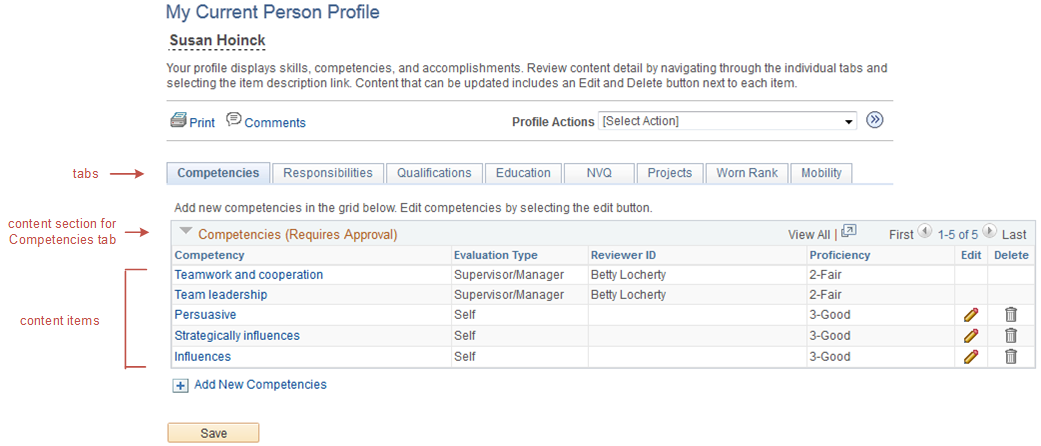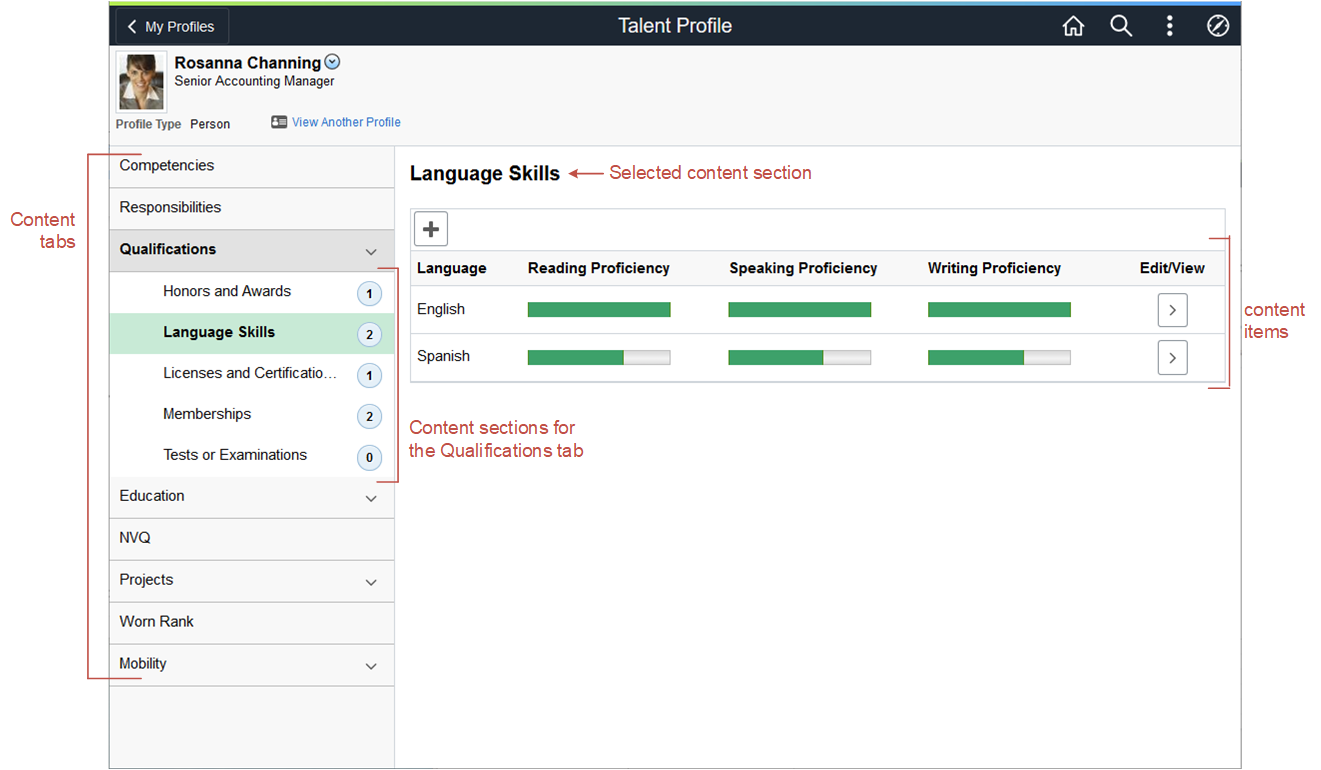Understanding Profile Maintenance
eDevelopment provides employees and managers with self-service options that integrate with the Manage Profiles business process in PeopleSoft HR. eDevelopment profiles are divided into two categories:
Person profiles.
Person profiles describe a person's skills, competencies, accomplishments and performance. Person profiles are linked to a person ID.
Job profiles.
Job profiles (known as non-person profiles in the Manage Profiles business process) describe the competencies, qualifications, and responsibilities of a job. You can link job profiles to a variety of entities, not just job codes. For example, job profiles can also be linked to positions, job families, and salary grades.
The format of profiles is the same in eDevelopment and the Manage Profiles business process. Profile content is divided into tabs and content sections that are defined by the profile type used to create the profile.
See Understanding Profiles and Profile Types.
The following topics discuss the self-service profile management options available to employees and managers that enable them to perform the following transactions:
|
Profile Management Transaction |
Classic User Interface Pages |
Fluid User Interface Pages |
|---|---|---|
|
Create and maintain your own person profile. |
Employees use the My Current Profile transaction to view and edit their existing person profiles and create new profiles. Employees also use the My Historical Profile option to view historical rows of their profile. See (Classic) Maintaining Person Profiles as an Employee or Manager. |
Employees use the Talent Profile Tile and page to view and edit their existing person profiles and create new profiles. When historical profile data exists for an item, theses pages will display the View History button for the row, which opens the View Profile Item History page to access historical rows of their profile. |
|
Create and maintain your team members’ profiles. |
Managers can create, view, and update the person profiles for their team using the Current Team Profiles Page. The manager Team Historical Profile transaction displays historical profile items in effect for direct reports as of the as of date. See (Classic) Maintaining Person Profiles as an Employee or Manager. |
Managers can create, view, and update the person profiles for their team using the Team Talent Profile Tile and pages. When historical profile data exists for a profile item, theses pages display the View History button for that row, where you can access historical data. |
|
Approve changes to person or non-person profiles. |
Managers use the Approve Profiles page to review changes to their employees' person profiles that require approval, and approve or deny the changes. See (Classic) Approving Person Profile Changes and Viewing Approval History. |
Managers use the Pending Approvals - Person Profile Page or Pending Approvals - Non-Person Profile Page to review changes to their employees' person profiles or non-person profile changes that require approval, and approve or deny the changes. |
|
View approval history. |
Employees use the Profile Approval History page in classic to view the approval status of profile changes that they have submitted for approval and view the history of profile approvals. See (Classic) Approving Person Profile Changes and Viewing Approval History. |
Employees use the Approvals History PageApproval History option in fluid to view the approval status of profile changes that they have submitted for approval and view the history of profile approvals. |
|
Manage interest lists. Note: An interest list is a collection of job profiles that is associated with an employee. Typically interest lists are used to identify jobs that an employee is interested in applying for, or jobs that match an employee's profile, or jobs that an employee wants to include in a career planning discussion with their manager. |
Employees can add to and remove job profiles from their interest list using the My Interest List Page. Managers can view and update their employees' interest lists using the Team Interest Lists Page. |
Employees can add to and remove job profiles from their interest list using the My Interest List Tile and pages. Managers can view and update their employees' interest lists using the Team Interest List Tile and pages. |
|
View job profiles. |
Employees have two options for viewing job (non-person) profiles:
|
Employees have two options for viewing job (non-person) profiles:
|
|
Create and maintain job profiles (manager only). Note: Depending on the configuration of your profile types, approvals workflow is triggered when managers update job profiles. The typical approver for job profiles is the profile administrator, although this can be configured according to your business needs. |
Managers can create and update job profiles using the Maintain Job Profiles page. |
Managers can create and update job profiles using the Maintain Job Profiles Tile (for Managers) and pages. |
|
Search and compare profiles. |
Employees and managers use Search and Compare Profiles to run any of the search types that have been configured for them. |
Employees and managers use Search / Compare Profiles Tile and pages to run any of the search types that have been configured for them. |
Employees can have one or more profiles, but only one profile per profile type. The PeopleSoft application delivers the profile type PERSON to create person profiles, but you can create other profile types according to your organizational requirements. For further information about creating profile types see Creating Profile Group Types and Profile Groups.
Employees and managers use the Profile Details page to view and update person profiles.
This is an example of a person profile using the classic user interface.

This is an example of a person profile using the fluid user interface.

Profile content is divided into tabs which appear as tabs on the page. Under the navigation tabs, the page lists the content sections of the tab. When the employee or manager selects a different tab, the system updates the page to show the content sections for that tab. The content sections that employees and managers can view and update is determined by the security settings for the content sections in the profile type definition. This means that the profile content can vary according to the role accessing the profile.
Employees and managers add items to the person profile from the content catalog that you set up in Manage Profiles.
Note: (Classic) When using the classic pages, they can also copy items from job profiles that are related to the employee's job, by selecting Copy From Job Profile in the Profile Actions field and clicking the Go icon. The system searches for job profiles that match the employee's job data. There could be more than one profile related to the employee's job data. For example, if you have set up profiles for job codes and positions and the person has a position selected in job data, the system lists these profiles and the employee or manager selects the profile that they want to use.
The profile pages list items within the content sections of the page. If changes have been made to the profile but not yet approved, The pages indicates that there are items that are either new and awaiting submission for approval, pending approval, or denied. In classic mode, the employee or manager click a link to view a list of the items with that approval status. In fluid mode, the Status field appears, indicating which items have that approval status.
Content requiring approval whose items are added, updated, or deleted from a profile are assigned a saved status in the classic pages when the employee or manager saves and submits the information for approval.
For changes that don't require approval, the items are automatically set to approved when the employee or manager saves and the profile page is updated with the changes.
Warning! (Classic) After those items requiring approval are submitted using the classic page, the content section on the profile page is refreshed to show approved items only. This means that the changes that were saved are no longer visible because these items do not have an approved status. However, a link appears to indicate that there are items pending approval.
(Fluid) After those items requiring approval are submitted using the fluid pages, the content section on the profile page is refreshed to show the Pending Approval status for the item.
Before employees and managers can use the profile management self-service transactions, you must set up the following:
Define the content catalog.
Define your profile types.
(Optional). Define profile groups.
(Optional). Define and configure approvals for profiles.
The use of approval processing for profiles is optional. You associate approvals workflow to profile types.
Define search types and run the Build Manager List and Build Profile Search Indexes processes required by the profile search and compare feature.
Set up the text on the self-service pages.
The profile management self-services pages use the Text Catalog. You can modify the delivered text to meet your organization's business needs. See Configuring the Text Catalog.
Configure the Direct Reports functionality for your organization.
The manager self-service options for profile management use the direct reports functionality to determine managers' direct reports. See Configuring Direct Reports Functionality.